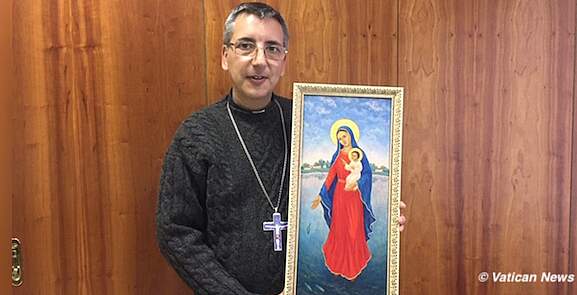
Bishop José Luis Mumbiela Sierra, of the diocese of Holy Trinity in Almaty, Kazakhstan, was visiting Rome in early 2019. He brought with him as a gift for the Pope a picture that he commissioned to commemorate an historical event:
“This is a painting that commemorates a special moment in the history of part of the Catholic population of Kazakhstan, in a town in the north of the country, populated by Polish deportees who were taken there in 1935-36.” The event took place in 1941, when a famine was worsening in the little town: “With temperatures from -40 to -58ºF, with two meters of snow… just try to make a living there!” exclaimed the bishop.
In this situation, “the Poles, good people that they are, turned to the Virgin in their prayers,” and asked for the miracle of her intercession. “And lo and behold, around March 25, 1941, the snow melted, and a lake formed, and in that lake, fish appeared! And thanks to those fish, the people were saved, as well as some other people from neighboring villages.”
On the centenary of the Virgin of Fatima, “more or less the same situation occurred again,” he recounts. “We can’t definitively say that this event is a miracle of the Virgin, but in the end, the faithful see the maternal hand of the Virgin, who intercedes for her children.”
“There had not previously been a special image there to commemorate that historical event, so I commissioned a painting that would commemorate it—not Mary giving them the fish herself, but it’s the Child Jesus in her arms who gives the fish to his Mother, and the Mother throws the fish into the nets—that represent our prayers, and those nets are thrown into the lake of mercy,” he said.
Adapted from Vatican News